 W
WThis is an incomplete list of paintings by the French painter Paul Gauguin.
 W
WArearea is an 1892 work by French painter Paul Gauguin. It was one of the works Gauguin exhibited at his 1893 Durand-Ruel exhibition in Paris. It was bequeathed to the French state in 1961, and was in the collection of the Louvre. From 1986, the painting has been in the collection of the Musée d'Orsay. The prominence in his paintings of collarless free range dogs has been the subject of much speculation as to their symbolic or metaphorical meaning.
 W
WArearea no varua ino is an 1894 painting by Paul Gauguin, now in the Ny Carlsberg Glyptotek in Copenhagen.
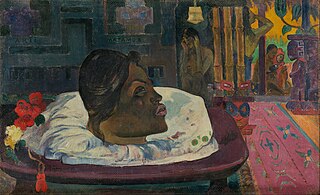 W
WArii Matamoe or The Royal End is a painting on coarse cloth by the French artist Paul Gauguin, created in 1892 during the painter's first visit to Tahiti. It depicts a man's severed head on a pillow, displayed before mourners, and although it did not depict a common or contemporary Tahitian mourning ritual, may have been inspired by the death of Pōmare V in 1891 shortly after Gauguin's arrival. A curator for the J. Paul Getty Museum suggested Gauguin likely painted the canvas "to shock Parisians" upon his expected return to the city.
 W
WThe Beautiful Angel is an 1889 painting by Paul Gauguin, now in the Musée d'Orsay in Paris. Its title derives from a nickname for its subject, Angélique Marie Satre (1868-1932) - she was one of three famous innkeepers in Pont-Aven, where the work was produced. Its style is heavily influenced by the 'Japonism' then fashionable in Paris, particularly by a canvas by Hokusai.
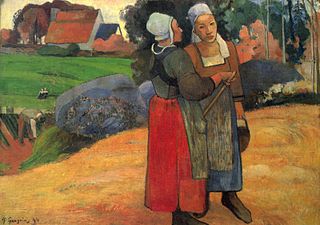 W
WBreton Peasant Women is an 1894 oil on canvas painting by Paul Gauguin of two Breton peasant women in conversation. It is now in the Musée d'Orsay in Paris.
 W
WThe Call is a 1902 painting by Paul Gauguin, produced in Polynesia a year before the artist's death. It is now in the Cleveland Museum of Art.
 W
WThe Green Christ is a painting executed by Paul Gauguin in autumn 1889 in Pont-Aven, Brittany, France. Together with The Yellow Christ, it is considered to be one of the key-works of Symbolism in painting. It depicts a Breton woman at the foot of a calvary, or sculpture of Christ's crucifixion. Calvaries are common in town squares in Brittany. The woman appears to be hiding from a pair of figures in the distant background; the green christ providing her cover from the figures.
 W
WChrist On the Mount of Olives is an 1889 painting by French artist Paul Gauguin. It is both a self-portrait and a representation of Jesus about to be taken by the soldiers.
 W
WThe Yellow Christ is a painting executed by Paul Gauguin in 1889 in Pont-Aven. Together with The Green Christ, it is considered to be one of the key works of Symbolism in painting.
 W
WEiaha Ohipa is an 1896 oil on canvas painting by Paul Gauguin, now in Pushkin Museum, Moscow. It was produced during his second stay in Tahiti
 W
WFatata te Miti is an 1892 oil painting by French artist Paul Gauguin, located in the National Gallery of Art, in Washington, DC.
 W
WFields by the Sea is an 1889 oil on canvas painting by Paul Gauguin. It is also called Landscape from Bretagne. The painting is exhibited at the Nationalmuseum in Stockholm.
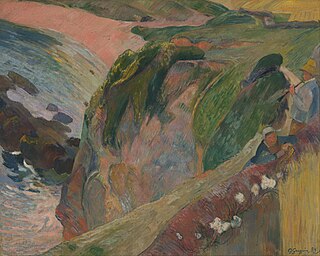 W
WThe Flageolet Player on the Cliff is an 1889 oil painting by French artist Paul Gauguin, located in the Indianapolis Museum of Art, which is in Indianapolis, Indiana. It depicts a Breton couple on a narrow path precipitously overlooking the Atlantic.
 W
WFruits on a Table or Still Life with Apples and Grapes is a still life painting by French artist Paul Gauguin painted in 1889. It was one of two works stolen from the private collection of Terence F. Kennedy in London in June 1970 and recovered by the Carabinieri in Italy in April 2014.
 W
WIa Orana Maria is an 1891 oil on canvas painting by Paul Gauguin, now in the Metropolitan Museum of Art. It is one of the first works in his Tahitian period and shows two Polynesians (centre) greeting the Madonna and Child.
 W
WLandscape near Arles is an 1888 oil painting by French artist Paul Gauguin, located in the Indianapolis Museum of Art, which is in Indianapolis, Indiana. It depicts a rural scene in Provence.
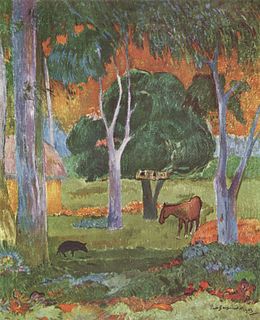 W
WLandscape with a Pig and a Horse or Landscape, La Dominique is a 1903 oil painting by Paul Gauguin. Since 1908 it has been in the collection of the Ateneum in Helsinki. One of his last works, it was painted on Hiva Oa island.
 W
WMahana no atua is an 1894 oil painting by the French Post-Impressionist artist Paul Gauguin which is in the collection of the Art Institute of Chicago.
 W
WA Man with an Axe is an 1891 oil on canvas painting by Paul Gauguin, now in a Swiss private collection. A study for it is now in the Art Institute of Chicago.
 W
WMerahi metua no Tehamana is an 1893 painting by the French artist Paul Gauguin, currently in the collection of the Art Institute of Chicago. The painting is a portrait of Paul Gauguin's wife Teha'amana during his first visit to Tahiti in 1891–1893. This marriage has always provoked controversy because it was arranged and completed in the course of a single afternoon and Gauguin claimed Teha'amana was just thirteen years old at the time.
 W
WNave Nave Mahana was made in 1896 by Paul Gauguin in Tahiti. It is kept in the Museum of Fine Arts of Lyon. The painting became part of the collections of the Lyon Museum in 1913.
 W
WNave nave moe is an oil on canvas painting by Paul Gauguin, produced in Paris in 1894 but inspired by his trip to Tahiti three years earlier. It is now in the Hermitage Museum.
 W
WNevermore is an 1897 oil on canvas painting by the French Post-Impressionist artist Paul Gauguin. Since 1932 it has been in the collection of the Courtauld Institute of Art and on display in the Gallery. It was executed during the artist's second stay on the island of Tahiti in the South Pacific.
 W
WThe Painter of Sunflowers is a portrait of Vincent van Gogh by Paul Gauguin in December 1888.
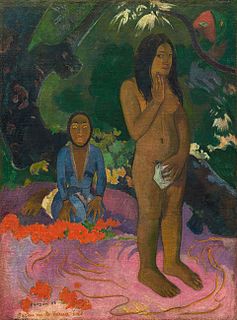 W
WParau na te varaua ino is an 1892 oil on canvas painting by Paul Gauguin, produced during the artist's first stay on Tahiti. It is now in the National Gallery of Art
 W
WPortrait of Madame Roulin is an oil on canvas portrait by Paul Gauguin of Augustine Roullin, wife of the postman Joseph Roulin (1841-1903). It is now in the St Louis Museum of Art.
 W
WThe Schuffenecker Family or Schuffenecker's Studio is an 1889 oil on canvas painting by Paul Gauguin, now in the Musée d'Orsay. It shows the artist's painter friend Émile Schuffenecker with his wife Louise Lançon and their two children Jeanne and Paul. On the wall to the right of the window is a still-life with fruits and a Japanese print, reflecting the then-fashionable Japonism.
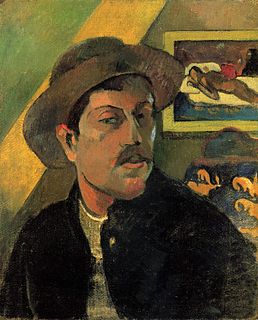 W
WSelf-Portrait in a Hat is an 1893 oil on canvas self portrait by Paul Gauguin, produced following a trip to Tahiti. He shows himself in his Paris studio with Spirit of the Dead Watching in the background. It is now in the Musée d’Orsay in Paris.
 W
WSelf-Portrait with Halo and Snake, also known as Self-Portrait, is an 1889 oil on wood painting by French artist Paul Gauguin, which represents his late Brittany period in the fishing village of Le Pouldu in northwestern France. No longer comfortable with Pont-Aven, Gauguin moved on to Le Pouldu with his friend and student Meijer de Haan and a small group of artists. He stayed for several months in the autumn of 1889 and the summer of 1890, where the group spent their time decorating the interior of Marie Henry's inn with every major type of art work. Gauguin painted his Self-Portrait in the dining room with its companion piece, Portrait of Jacob Meyer de Haan (1889).
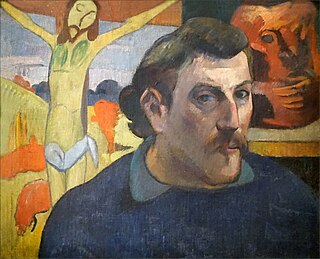 W
WSelf-Portrait with the Yellow Christ is an 1890 or 1891 painting by Paul Gauguin, produced in Pont-Aven in Brittany and now in the musée d'Orsay in Paris, to which it was assigned after its purchase by the French state in 1994 with financial assistance from Philippe Meyer and a Japanese patron.
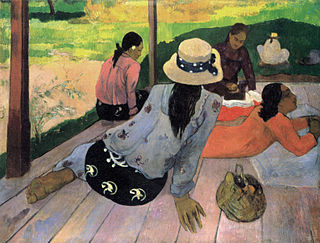 W
WThe Siesta is an 1892-1894 oil on canvas painting by Paul Gauguin, now in the Metropolitan Museum of Art in New York. It was painted during Gauguin's first extended trip to the island of Tahiti.
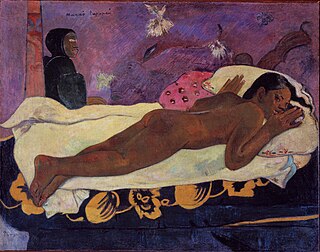 W
WSpirit of the Dead Watching is an 1892 oil on burlap canvas painting by Paul Gauguin, depicting a naked Tahitian girl lying on her stomach. An old woman is seated behind her. Gauguin said the title may refer to either the girl imagining the ghost, or the ghost imagining her.
 W
WStill Life with a Sketch after Delacroix is an oil painting by the French artist Paul Gauguin. The undated work is thought to have been painted during the artist's 1887 stay in Martinique. It was bequeathed to the Strasbourg museum by Raymond Koechlin in 1931 and is now on display in the Musée d'Art moderne et contemporain. Its inventory number is 55.974.0.662.
 W
WStill Life with Head-Shaped Vase and Japanese Woodcut is an 1889 still life painting by French artist, Paul Gauguin. It is currently in the collection of the Museum of Contemporary Art in Tehran, Iran.
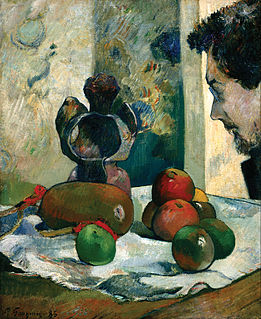 W
WStill Life with Profile of Laval is an 1886 oil painting by French artist Paul Gauguin, located in the Indianapolis Museum of Art, which is in Indianapolis, Indiana. It depicts Gauguin's friend Charles Laval in profile with an assortment of inanimate objects, including a ceramic pot Gauguin made himself.
 W
WStudy of a Nude, or Suzanne sewing is an 1880 painting made by Paul Gauguin in Paris. It is currently in the collection of the Ny Carlsberg Glyptotek in Copenhagen. The painting depicts a young woman who is arranging a garment in undisguised nakedness.
 W
WTahitian Woman and Boy is an 1899 painting by Paul Gauguin, now in the Norton Simon Museum, to which it was donated in 1976.
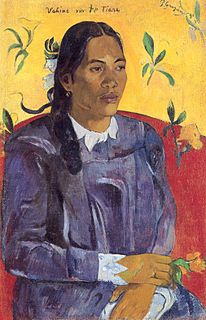 W
WTahitian Woman with a Flower is an 1891 painting by Paul Gauguin, now in the Ny Carlsberg Glyptotek in Copenhagen.
 W
WTahitian Women on the Beach is an 1891 painting by Paul Gauguin. The painting depicts two women on the Pacific island of Tahiti on the beach.
 W
WTe tamari no atua or The Birth is an 1896 oil on canvas painting by Paul Gauguin, now in the Neue Pinakothek in Munich. It forms a Nativity in Polynesian guise.
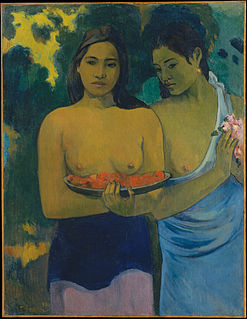 W
WTwo Tahitian Women is an 1899 painting by Paul Gauguin. It depicts two topless women, one holding mango blossoms, on the Pacific Island of Tahiti. The painting is part of the permanent collection of the Metropolitan Museum of Art in New York City and was donated to the museum by William Church Osborn in 1949.
 W
WVahine no te vi is an 1892 painting by Paul Gauguin, currently in the collection of the Baltimore Museum of Art. It is one of the earliest of about seventy paintings he produced during his first visit to Tahiti and is one of many works of modern art in the museum's Cone Collection.
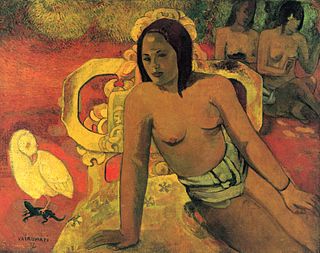 W
WVairumati is an 1897 oil on canvas painting by Paul Gauguin, now in the Musée d'Orsay in Paris.
 W
WVairumati tei Oa is an 1892 painting by Paul Gauguin, produced during its time in Polynesia. Its title translates as Her name was Vairaumati. It remained in the artist's family before passing to Ambroise Vollard's gallery in Paris. Sergei Schukin acquired it from the latter in 1904 and in 1918 it was acquired by the 1st Museum of New Western Painting. Since 1948 it has been in the Pushkin Museum in Moscow.
 W
WLe violoncelliste is an oil painting by Paul Gauguin which is kept in the Baltimore Museum of Art.
 W
WVision after the Sermon is an oil painting by French artist Paul Gauguin, completed in 1888. It is now in the Scottish National Gallery, Edinburgh. It depicts a scene from the Bible in which Jacob wrestles an angel. It depicts this indirectly, through a vision that the women depicted see after a sermon in church. It was painted in Pont-Aven, Brittany, France.
 W
WThe Wave is an 1888 painting by Paul Gauguin. It was purchased by David Rockefeller, an American banking executive, in 1966.
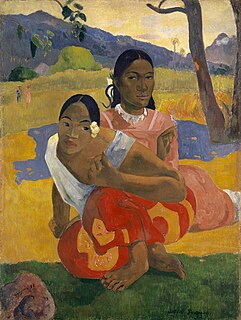 W
WWhen Will You Marry? is an oil painting from 1892 by the French Post-Impressionist artist Paul Gauguin. On loan to the Kunstmuseum in Basel, Switzerland for nearly a half-century, it was sold privately by the family of Rudolf Staechelin to Sheikha Al-Mayassa bint Hamad Al-Thani, in February 2015 for close to US$210 million, one of the highest prices ever paid for a work of art. The painting was on exhibition at the Fondation Beyeler, Riehen, until 28 June 2015.
 W
WWhere Do We Come From? What Are We? Where Are We Going? is a painting by French artist Paul Gauguin. The painting was created in Tahiti, and is in the Museum of Fine Arts in Boston, Massachusetts, US. Viewed a masterpiece by Gauguin, the painting is considered "a philosophical work comparable to the themes of the Gospels".